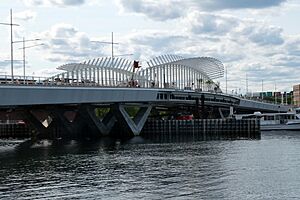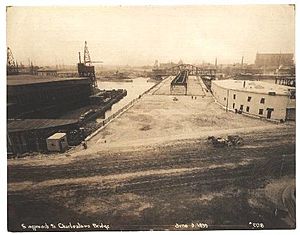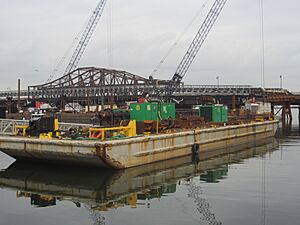Charlestown Bridge facts for kids
Quick facts for kids Charlestown Bridge |
|
|---|---|

Bill Russell Bridge in June 2025
|
|
| Coordinates | 42°22′08″N 71°03′36″W / 42.36889°N 71.06000°W |
| Carries | North Washington Street |
| Crosses | Charles River |
| Locale | Boston, Massachusetts |
| Official name |
|
| Other name(s) | North End Bridge |
| Maintained by | City of Boston |
| Characteristics | |
| Design | Plate girder bridge approaches, with truss swing span |
| Total length | 1,089 ft (332 m) |
| Width | 66 ft (20 m) |
| Number of spans | One (241.2 ft [73.5 m]) |
| History | |
| Designer | William Jackson |
| Construction begin | 1898, 2018 |
| Construction end | 1900, 2025 (scheduled) |
| Opened | 1900, 2025 (scheduled) |
| Replaces | Charles River Bridge (1786) |
| Statistics | |
| Daily traffic | 38,400 cars/day (2010) |
The William Felton "Bill" Russell Bridge, often called the Charlestown Bridge, is a famous crossing in Boston. It stretches over the Charles River, connecting the neighborhoods of Charlestown and the North End. This bridge is the easternmost crossing on the river.
It's also an important part of the Freedom Trail. This trail links historical sites like the USS Constitution ship and the Bunker Hill Monument. North of the bridge, Route 99 begins, changing into New Rutherford Avenue.
The first version of this bridge was finished in 1900. A project to replace that bridge began in late 2018. After some delays, the new bridge's construction was completed in August 2025. In October 2024, the new bridge was named to honor Bill Russell. He was a legendary player for the Boston Celtics basketball team and received the Presidential Medal of Freedom.
Contents
History of the Charlestown Bridge
The very first way to cross the Charles River here was by ferry. This ferry service started in the 1630s. In 1640, Harvard College was given the ferry's income to help support the school. Harvard managed this ferry for many years, until 1785.
The First Bridge: Charles River Bridge
The first actual bridge on this spot was called the Charles River Bridge. It was approved in 1785 and opened on June 17, 1786. This bridge was built and run by private companies. They collected tolls from people crossing to make a profit.
When the bridge was approved, Harvard College received money each year. This was to make up for the money they lost from the ferry no longer being needed.
The 1900 Bridge Design
The bridge that stood for over a century was built in 1900. William Jackson was the chief engineer for this project. It was designed to carry both cars and an elevated railroad line.
The elevated railway was taken down in 1975. This made way for a new subway line, the MBTA Orange Line. The new Orange Line was rerouted to avoid going directly through the busy Charlestown neighborhood.
The Haymarket Tunnel opened in 1975. This tunnel, located south of the new Orange Line Community College station, became the path for Orange Line trains.
Because the 1900 bridge was built for both trains and cars, it had six lanes. In 2003, the two middle lanes were permanently closed to traffic.
The New Bill Russell Bridge
Work on replacing the old bridge began in late 2018. The new bridge was designed by architect Miguel Rosales with Alfred Benesch & Company. Its look is meant to match the nearby Zakim Bridge, which Rosales also helped design.
The new bridge has two lanes for cars in each direction. It also has a special lane for southbound buses. Plus, there are protected lanes for bicycles and sidewalks on both sides for people walking. During construction, a temporary bridge was used for pedestrians and some car traffic.
The new bridge cost about $180 million. It was originally planned to be finished in 2023. However, problems with some steel parts caused delays. Construction was completed in August 2025.
Why the Bridge is Named After Bill Russell
The bridge was officially known as the North Washington Street Bridge until 2024. In October 2024, the new bridge was officially named the William Felton "Bill" Russell Bridge. This honors Bill Russell, a true sports legend.
Bill Russell played for the Boston Celtics basketball team from 1956 to 1969. During his time, the Celtics won an amazing 11 NBA championships! He was also a player-coach for the team.
Locally, people often called the bridge the Charlestown Bridge. Some residents of Charlestown even called it the North End Bridge. The new official name, the Bill Russell Bridge, helps settle this long-standing debate.



